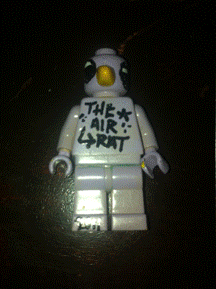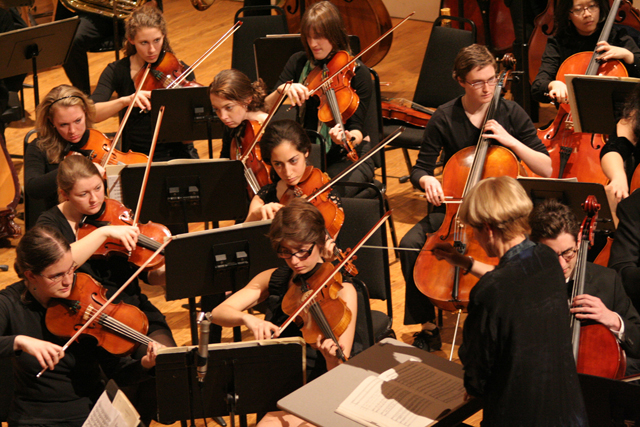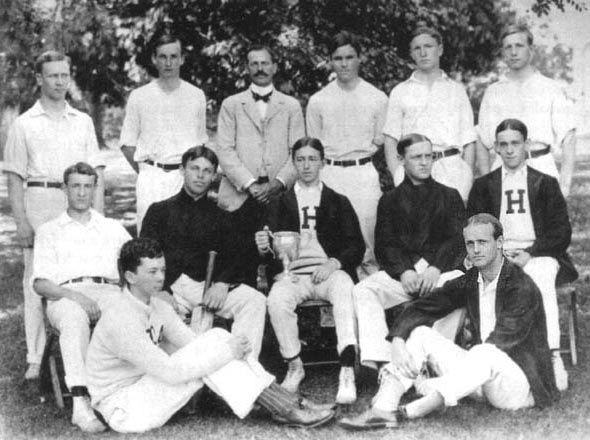The life and times of the street artist named Air Rat
By Sam Fox
At first glance, Air Rat looks like the kind of guy you’d like to bring home to your parents. He has a neatly-trimmed beard and a “Mad Men” style coiffure. Today, he is wearing a pea coat over a matching blue button-up, and he is offering to buy me a cup of coffee.
We have met at a Starbucks in Old City–his suggestion–so he can show me pictures of his various art projects and then take a tour of his street art in the area. It’s a shame it’s raining, he says, because he would have liked to “put up” some pieces during the tour.
Sitting down at a table by the window, he pulls out a laptop and begins flipping through a selection of images culled from the 4,500-photograph gallery on his phone. As he turns his head towards the computer and types, tattoos wink in and out of view: between his fingers, behind his ears, and poking out from under his shirt collar. They are the first signs that he might not be so square, and once you learn to look for them, they keep showing up.
When asked what mediums he works in, he says “everything.” This is not far from the truth. He paints, stencils, sculpts, makes wood cuts, crafts stickers, and reappropriates trash.
The artist’s alias comes from a solo show he did a number of years ago, which featured cartoonish pigeon sculptures. Some of the birds were clear, others had glow-in-the-dark skulls. “Air rat” is slang for pigeon, so the artist  decided to adopt the name for his own pigeons, and, later, for himself.
decided to adopt the name for his own pigeons, and, later, for himself.
Air Rat identifies with pigeons because of their “roll with the punches” attitude. Though the artist has faced a number of legal, physical, and financial obstacles, he persists in his work much like the hardy, ever-present bird.
Right now, Air Rat is passionate about two main projects: one involving glass etch and the other involving Legos. Both projects move between the street and the gallery.
One of his first glass etch projects was a kitschy Ouija board, which earned him encouragement from other artists to pursue the medium further. Next, he completed a series of 40 hand-etched glass bottles that serve as aquariums for beta fish. A more recent project involved candle votives, which, when lit, project dancing shadows on their surroundings.
These functional, gallery-suited pieces are complemented by more informal work. If he is in a bar at 2 a.m. and nobody is there, he might run into the womens’ bathroom and do a quick piece on the mirror. He has learned that these pieces often get posted on Instagram later–unless he is interrupted mid-etch by a closing-time employee.
Since glass etching is so destructive, a Buddhist friend has given him advice for fostering good karma: only etch things that have already been etched. Air Rat says this goes against the graffiti artist ethos of doing whatever you want, wherever you want, but the idea stands to help him in the future. He has received plenty of angry phone calls for his etchings. In response, he even got a tattoo of a bottle of etching chemicals, wrapped with a banner that says “So Sorry.”
Air Rat’s Lego project involves casting resin replicas of Lego minifigures and gluing them in “little nooks” around the city. He has teamed up with photographer Matthew Kendig, who documents the installations as they change within the volatile, human “playscape” of Philadelphia. Thanks to passersby and shifts in weather, figures fade, get melted, dismembered, and taken. Fifteen of Kendig’s photographs have been assembled into a “one-page book” for a show at the Church Gallery in OldCity. The two plan on continuing the project with other galleries, but these ideas are still in the works.
After reading a pictorial history of the Lego minifigure, Air Rat discovered that Lego made a series of minifigures in the image of the founder of the Adult Fan of Lego association, as a tribute to the man’s popularization of the toy. Perhaps, Air Rat dreams, one day Lego will make an Air Rat Lego. Either that, he muses, or the toy manufacturer will sue him.
Both the Lego project and the glass etchings represent Air Rat’s two main artististic visions: developing a connecting theme and struggling against transience.
Though he is critical of most other Philadelphia street artists, he looks to stikman as a sort of model for these visions. Even though stikman works with stickers, wood cuts, and other materials, his work is always recognizable because of the character he uses. The artist also introduced Air Rat to the idea that all art is “ephemeral,” a word Air Rat now uses constantly, with urgency and reverence.
Love of the ephemeral
“Everything I feel like I’ve been doing has been an attempt to beat that idea [of ephemerality],” he says.
Street art is frequently removed or painted over soon after it is put up. And even when the art lasts, the structure on which it is plastered eventually gets torn down or altered. In order to combat the ephemeral nature of street art, Air Rat began taking pictures of his work and posting them on Instagram. And yet, as one of his friends pointed out to him, Instagram is just as ephemeral as the street. Pictures of art get lost in the hundreds of other images people receive on a daily basis.
The trick, Air Rat realizes, is to find a medium that makes a lasting impression. In each of his projects, he remains in search of a “fountain of youth.”
The pursuit of these lofty goals has been a long time in development. Continue reading









